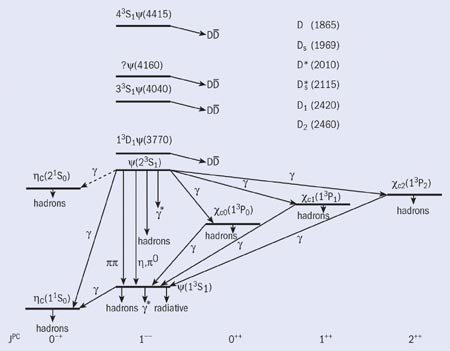This year, the Beijing Spectrometer (BES) experiment running at the Beijing Electron Positron Collider (BEPC) completed a run at the energy of the y(2S) resonance. The run began in November 2001 and lasted until March 2002, a total of 111 days. BES accumulated 14 million events, which is the world’s largest sample of y(2S) events produced from electron-positron annihilation. BES collected the previous largest data sample of 4 million events in 1993-1995. The new sample will allow the properties and decays of the y(2S) and other charm quark bound states produced by y(2S) decays to be studied with increased precision.
The y(2S) resonance was discovered in 1974 by the Mark I experiment at California’s Stanford Linear Accelerator Center (SLAC) shortly after the discovery of the J/y. Both resonances are composed of a charm quark and an anticharm quark. The discovery of the J/y and y(2S) particles was crucial in establishing the quark model, in which almost all observed mesons and baryons can be described as composite objects made of quarks held together by the strong force. The theory that describes this is quantum chromodynamics (QCD), in which the carriers of the strong interaction are gluons, and the quarks are held together by gluon exchange.

The y(2S) is an excited state of the J/y. Although some properties are similar, the y(2S) is more massive than the J/y, so it can decay into other charm-anticharm states (such as the spin-zero hc and the three spin-1 cc states, as well as the J/y itself). This allows the physics of many charmonium states to be studied using the y(2S) sample (figure 1). Indeed, the study of the y(2S) sample collected in 1993-1995 at BES has proved to be very fruitful and important in testing QCD calculations on quarkonium production and decay dynamics. The clean signature and the large production rates of the cc states in y (2S) decays are big advantages of this study. Furthermore, the sample can also be used to study light hadron spectroscopy from the decay products of the cc states, where the quantum numbers of the initial states are well defined and are different for cc0, cc1 and cc2.
The biggest mystery in y(2S) decays is the so-called r p puzzle. In perturbative QCD, the decays of the charmonium states, J/y and y(2S), into light hadrons are expected to be dominated by the annihilation of the charm and anticharm quarks into three gluons. In this simple picture, the partial width for decays into any exclusive hadronic state is proportional to the wave function at the origin squared, y(0)2, which is well determined from dilepton decays. Since the strong coupling constant does not change much between the J/y and y(2S) masses, it is reasonable to expect that for any exclusive hadronic state (h), the J/y and y(2S) decay branching fractions will scale as B(y(2S)Æh)/B(J/yÆh) = B(y(2S)Æe+e–)/B(J/yÆe+e–) = 12%.
This relationship is known as the 12% rule. Although it works reasonably well for a number of specific decay modes, it fails seriously in the case of y(2S) two-body decays to the vector-pseudoscalar meson final states, r p and K*-K. This anomaly was discovered by SLAC’s Mark II experiment. In addition, the BES group has reported violations of the 12% rule for vector-tensor decay modes. Although a number of theoretical explanations have been proposed, most of them do not provide a satisfactory solution. The large y(2S) event sample will allow more precise measurements of the branching ratios to better test the surviving theories.

During the BEPC run, a peak luminosity of 1.1 ¥ 1031 cm-2s-1 was reached, and a record 208 000 y(2S) events were accumulated in one day. The first round of reconstruction of all y(2S) events has been completed. Careful offline calibration of the data shows that the BES detector performed well, with a barrel time-of-flight resolution of 200 ps, dE/dx resolution of 8.5%, and a momentum resolution of 1.7*(1+p2)% (figure 2 gives a glimpse of detector performance).
Earlier, BES obtained a sample of 58 million J/y events, which is the world’s largest J/y sample from electron-positron collisions. The J/y and y(2S) samples are complementary, and together will provide information on a wide range of topics, as well as testing the 12% rule.








